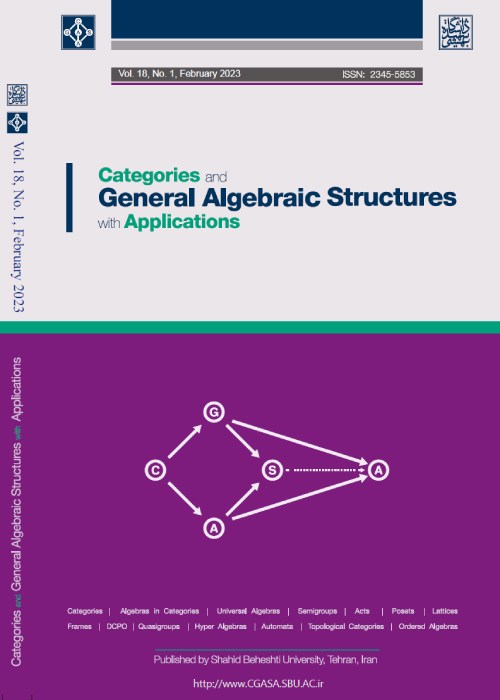فهرست مطالب

Categories and General Algebraic Structures with Applications
Volume:10 Issue: 1, Jan 2019
- تاریخ انتشار: 1397/10/29
- تعداد عناوین: 8
-
-
صفحات 17-37
-
صفحات 39-50
-
صفحات 51-67
-
صفحات 69-106
-
صفحات 107-116
-
صفحات 117-156
-
صفحات 157-171
-
Pages 1-15We call a local vector lattice any vector lattice with a distinguished positive strong unit and having exactly one maximal ideal (its radical). We provide a short study of local vector lattices. In this regards, some characterizations of local vector lattices are given. For instance, we prove that a vector lattice with a distinguished strong unit is local if and only if it is clean with non no-trivial components. Nevertheless, our main purpose is to prove, via what we call the radical functor, that the category of all vector lattices and lattice homomorphisms is equivalent to the category of local vectors lattices and unital (i.e., unit preserving) lattice homomorphisms.Keywords: category, equivalence functor, maximal ideal, local vector lattice, radical, lattice homomorphism, strong unit
-
Pages 17-37In this paper, we introduce the notions of prime state filters, obstinate state filters, and primary state filters in state residuated lattices and study some properties of them. Several characterizations of these state filters are given and the prime state filter theorem is proved. In addition, we investigate the relations between them.Keywords: State prime, state obstinate, state primary, state filter
-
Pages 39-50We show that the lattice of compactifications of a topological group G is a complete lattice which is isomorphic to the lattice of all closed normal subgroups of the Bohr compactification bG of G . The correspondence defines a contravariant functor from the category of topological groups to the category of complete lattices. Some properties of the compactification lattice of a topological group are obtained.Keywords: Topological group_compactification of a topological group_complete lattice
-
Pages 51-67In this paper first of all we introduce Property U-(G-PWP) of acts, which is an extension of Condition (G-PWP) and give some general properties. Then we give a characterization of monoids when this property of acts implies some others. Also we show that the strong (faithfulness, P-cyclicity) and (P-)regularity of acts imply the property U-(G-PWP). Finally, we give a necessary and sufficient condition under which all (cyclic, finitely generated) right acts or all (strongly, R-) torsion free (cyclic, finitely generated) right acts satisfy Property U-(G-PWP).Keywords: S-act, condition (PWP), condition (G-PWP), U-(G-PWP)
-
Pages 69-106\noindent We have two goals in this paper. First, we investigate and construct cofree coalgebras over n -representations of quivers, limits and colimits of n-representations of quivers, and limits and colimits of coalgebras in the monoidal categories of n-representations of quivers. Second, for any given quivers Q1,Q2,..., Qn, we construct a new quiver Q(Q1,Q2,...,Qn), called an n-quiver, and identify each category Repk(Qj) of representations of a quiver Qj as a full subcategory of the category Repk(Q(Q1,Q2,...,Qn)) of representations of Q(Q1,Q2,...,Qn) for every j∈{1,2,…,n}.Keywords: Quiver, Representation, birepresentation, n-representation, additive category, abelian category, k-linear category
-
Pages 107-116In this paper, we introduce and study a mapping from the collection of all intermediate rings of C(X) to the collection of all realcompactifications of X contained in βX. By establishing the relations between this mapping and its converse, we give a different approach to the main statements of De et. al.
Using these, we provide different answers to the four basic questions raised in Acharyya et.al. Finally, we give some notes on the realcompactifications generated by ideals.Keywords: Realcompacification, intermediate ring, intermediate C-ring -
Pages 117-156
In 2010, J. Climent Vidal and J. Soliveres Tur developed, among other things, a pair of 2-adjunctions between the 2-category of adjunctions and the 2-category of monads. One is related to the Kleisli adjunction and the other to the Eilenberg-Moore adjunction for a given monad.
Since any 2-adjunction induces certain natural isomorphisms of categories, these can be used to classify bijections and isomorphisms for certain structures in monad theory. In particular, one important example of a structure, lying in the 2-category of adjunctions, where this procedure can be applied to is that of a lifting. Therefore, a lifting can be characterized by the associated monad structure,lying in the 2-category of monads, through the respective 2-adjunction. The same can be said for Kleisli extensions.
Several authors have been discovered this type of bijections and isomorphisms but these pair of 2-adjunctions can collect them all at once with an extra property, that of naturality.Keywords: 2-categories, 2-adjunctions, monad theory, liftings for algebras, monoidal monads -
Pages 157-171In the definition of a crossed module (T,G,ρ), the actions of the group T and G on themselves are given by conjugation. In this paper, we consider these actions to be arbitrary and thus generalize the concept of ordinary crossed module. Therefore, we get the category GCM, of all generalized crossed modules and generalized crossed module morphisms between them, and investigate some of its categorical properties. In particular, we study the relations between epimorphisms and the surjective morphisms, and thus generalize the corresponding results of the category of (ordinary) crossed modules. By generalizing the conjugation action, we can find out what is the superiority of the conjugation to other actions. Also, we can find out a generalized crossed module with which other actions (other than the conjugation) has the properties same as a crossed module.Keywords: Group action, crossed module, generalized crossed module, category, monomorphism, epimorphism


